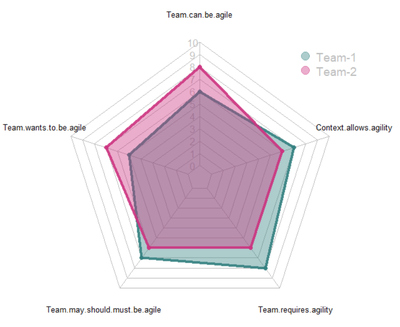 The maturity model according to Schmidt, Paetzold (2017) distinguishes 5 dimensions (see illustration):
The maturity model according to Schmidt, Paetzold (2017) distinguishes 5 dimensions (see illustration):The team can be agile: To what degree does the team have the necessary skills to be agile?
The team wants to be agile: To what degree does the team want to work agile?
The team should/must/may be agile: To what degree should, must or may the team be agile?
The team requires agility: To what degree are agile working methods required? (Or are alternative approaches such as Lean Development more appropriate for the given context?)
The context allows agility: To what degree does the product context permit agile development?
They are based on a total of 124 criteria that experienced practitioners and scientists rated as crucial in explorative interviews. The Fuzzy Set Theory is used to distribute the criteria to the dimensions and to analyse the answers. It is particularly suitable for complex contexts and takes into account subjectivity and uncertainties.
Simplified Example
A team that has the necessary knowledge (can be agile) and is intrinsically motivated (wants to be agile), but is not allowed to be agile due to a clear management decision (should/must/may), although they need it due to high uncertainties and the product context allows it, is always less mature than a team that also receives appropriate management support (see illustration). The larger the area in the spider diagram, the more agile the team is. A comparison of the dimensions reveals where measures should be taken to increase agility, for example.
Your Benefits
The model derives strengths and weaknesses of the team (actual situation). If these are known, recommendations for action can be derived in a target-oriented manner. In addition, the maturity level model provides new perspectives on the topic of agility (e. g.: Does the team need agile methods at all?) and thus promotes the critical self-reflection of the team as well as the anchoring of the maturity level concept. In other words, the application of the maturity model is a stimulus for the team to look at the agile approaches from a different perspective in order to reflect on their own approach and thus grow beyond themselves.
A detailed explanation of the maturity model can be found here:
Schmidt, T. S. and Paetzold, K. (2017), "Maturity Assessment of Teams Developing Physical Products in an Agile Manner", 23th International ICE Conference on Engineering, Technology and Innovation (ICE'17), Madeira, Portugal, 27.-29. Juni